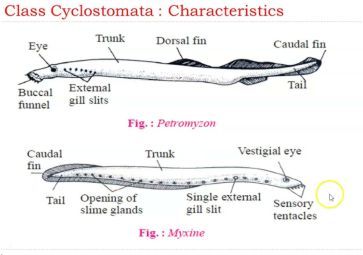Division - Agnatha (lack jaws)
Class - Cyclostomata
- Class Cyclostomata, also known as Agnatha, is a group of jawless fish that belong to the division Agnatha.
- They are primitive vertebrates and are characterised by the absence of jaws and paired fins. Cyclostomes include two extant orders: Myxini (hagfish) and Petromyzontida (lampreys).
General Characteristics:
- Cyclostomes are the most primitive and simplest vertebrates.
- They lack true jaws and paired fins.
- Their body is elongated and eel-like in shape.
- They have a cartilaginous endoskeleton, lacking bone.
- The body is covered with a slimy, scaleless skin.
Respiration:
- Cyclostomes respire primarily through gills, although some species also possess primitive lungs.
- Lampreys have a single nostril that connects to a nasohypophyseal sac, which is used for respiration.
Feeding Habits:
- Cyclostomes are parasitic or scavenging feeders.
- Lampreys are parasitic and attach themselves to the bodies of fish with their sucker-like mouth.
- Hagfish feed on dead or dying organisms by burrowing into the flesh and sucking out tissues.
Circulatory System:
- They possess a two-chambered heart with a single atrium and a single ventricle.
- Blood circulation is simple and lacks a true capillary network.
Excretion:
- Cyclostomes excrete nitrogenous wastes in the form of ammonia.
- They lack specialised excretory organs like kidneys and excrete waste through their skin and gills.
Reproduction:
- Cyclostomes are mostly dioecious (having separate sexes).
- Fertilisation is external, and they exhibit indirect development.
- Lampreys build nests and lay eggs in freshwater, while hagfish release eggs directly into the water.
Economic Importance:
- Some species of lampreys are consumed as food in certain cultures.
- Hagfish secrete a sticky slime when disturbed, which is used in various industries for making leather and other products.
Examples:
Petromyzon (Lamprey) and Myxine (Hagfish).
